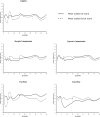Performance of Dutch children on the Bayley III: a comparison study of US and Dutch norms
- PMID: 26267907
- PMCID: PMC4534391
- DOI: 10.1371/journal.pone.0132871
Performance of Dutch children on the Bayley III: a comparison study of US and Dutch norms
Abstract
Background: The Bayley Scales of Infant and Toddler Development-third edition (Bayley-III) are frequently used to assess early child development worldwide. However, the original standardization only included US children, and it is still unclear whether or not these norms are adequate for use in other populations. Recently, norms for the Dutch version of the Bayley-III (The Bayley-III-NL) were made. Scores based on Dutch and US norms were compared to study the need for population-specific norms.
Methods: Scaled scores based on Dutch and US norms were compared for 1912 children between 14 days and 42 months 14 days. Next, the proportions of children scoring < 1-SD and < -2 SD based on the two norms were compared, to identify over- or under-referral for developmental delay resulting from non-population-based norms.
Results: Scaled scores based on Dutch norms fluctuated around values based on US norms on all subtests. The extent of the deviations differed across ages and subtests. Differences in means were significant across all five subtests (p < .01) with small to large effect sizes (ηp2) ranging from .03 to .26). Using the US instead of Dutch norms resulted in over-referral regarding gross motor skills, and under-referral regarding cognitive, receptive communication, expressive communication, and fine motor skills.
Conclusions: The Dutch norms differ from the US norms for all subtests and these differences are clinically relevant. Population specific norms are needed to identify children with low scores for referral and intervention, and to facilitate international comparisons of population data.
Conflict of interest statement
Figures
Similar articles
-
The Impact of Norms on the Outcome of Children Born Very-Preterm when Using the Bayley-III: Differences between US and German Norms.Neonatology. 2019;116(1):29-36. doi: 10.1159/000497138. Epub 2019 Mar 19. Neonatology. 2019. PMID: 30889586
-
A Comparison Study of the Tehran Norms to the Reference Norms on Children Performance of the Bayley III.Iran J Child Neurol. 2022 Spring;16(2):63-76. doi: 10.22037/ijcn.v16i2.32930. Epub 2022 Mar 14. Iran J Child Neurol. 2022. PMID: 35497097 Free PMC article.
-
Children born extremely preterm show significant lower cognitive, language and motor function levels compared with children born at term, as measured by the Bayley-III at 2.5 years.Acta Paediatr. 2014 May;103(5):504-11. doi: 10.1111/apa.12585. Epub 2014 Mar 7. Acta Paediatr. 2014. PMID: 24494838
-
Assessing developmental delay in early childhood - concerns with the Bayley-III scales.Clin Neuropsychol. 2017 Feb;31(2):371-381. doi: 10.1080/13854046.2016.1216518. Epub 2016 Aug 12. Clin Neuropsychol. 2017. PMID: 27687612 Review.
-
How to use the Bayley Scales of Infant and Toddler Development.Arch Dis Child Educ Pract Ed. 2021 Apr;106(2):108-112. doi: 10.1136/archdischild-2020-319063. Epub 2020 Aug 28. Arch Dis Child Educ Pract Ed. 2021. PMID: 32859738 Review.
Cited by
-
Presymptomatic treatment of classic late-infantile neuronal ceroid lipofuscinosis with cerliponase alfa.Orphanet J Rare Dis. 2021 May 14;16(1):221. doi: 10.1186/s13023-021-01858-6. Orphanet J Rare Dis. 2021. PMID: 33990214 Free PMC article.
-
Comparative analysis of developmental outcomes in very preterm infants: BSID-II versus Bayley-III German norms.PLoS One. 2025 Jan 27;20(1):e0318263. doi: 10.1371/journal.pone.0318263. eCollection 2025. PLoS One. 2025. PMID: 39869623 Free PMC article.
-
Acceptability and Reliability of the Bayley Scales of Infant and Toddler Development-III Among Children in Bhaktapur, Nepal.Front Psychol. 2018 Jul 24;9:1265. doi: 10.3389/fpsyg.2018.01265. eCollection 2018. Front Psychol. 2018. PMID: 30087639 Free PMC article.
-
Vulnerability of the Neonatal Connectome following Postnatal Stress.J Neurosci. 2022 Nov 30;42(48):8948-8959. doi: 10.1523/JNEUROSCI.0176-22.2022. Epub 2022 Nov 14. J Neurosci. 2022. PMID: 36376077 Free PMC article.
-
A comparison of the performance of normal middle social class Egyptian infants and toddlers with the reference norms of the Bayley Scales -third edition (Bayley III): A pilot study.PLoS One. 2021 Dec 2;16(12):e0260138. doi: 10.1371/journal.pone.0260138. eCollection 2021. PLoS One. 2021. PMID: 34855785 Free PMC article.
References
-
- Bayley N. Bayley Scales of Infant and Toddler Development-Third edition. San Antonio, TX: Hartcourt assessments, inc; 2006.
-
- Bayley N. The Bayley Scales of Infant Development. 2nd ed. San Antonio, TX: The Psychological Corporation; 1993.
-
- Chinta S, Walker K, Halliday R, Loughran-Fowlds A, Badawi N. A comparison of the performance of healthy Australian 3-year-olds with the standardised norms of the Bayley Scales of Infant and Toddler Development (version-III). Arch Dis Child 2014. February 6. - PubMed
Publication types
MeSH terms
LinkOut - more resources
Full Text Sources
Other Literature Sources
Medical


